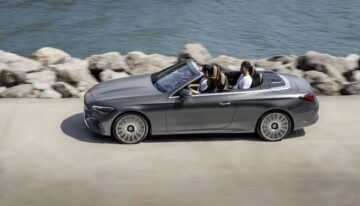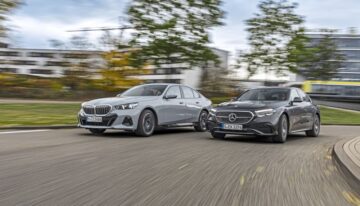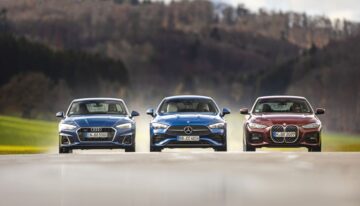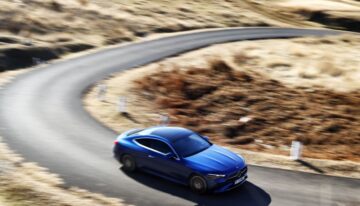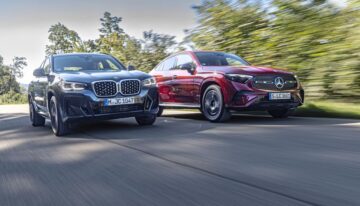German magazine Auto Motor und Sport has conducted a comparison test between the new Mercedes E 220 d 4Matic and the BMW 520d xDrive, with the Mercedes E-Class coming out on top.
For the second time in history, the new generation Mercedes E-Class and BMW 5 Series are being launched at the same time. BMW and Mercedes have a different strategy in the business class. The Mercedes E-Class is built on the MRA II platform for the mild hybrid and Plug-in Hybrid versions, while the electric version EQE is based on the dedicated EVA II platform. BMW uses a multi-drive platform, with the petrol, diesel, plug-in hybrid, and electric versions built on the same architecture.
Photo: Auto motor und sport
Big surprise: Mercedes is more agile and comfortable
Both models come with a noble drivetrain: all-wheel drive, all-wheel steering (2.5 degrees maximum steering angle) and adaptive suspension in the BMW 520 d xDrive and all-wheel drive, all-wheel steering (4.5 degrees steering angle) and adaptive air suspension in the Mercedes E 220 d 4Matic.
Even in the fairly innocuous 220 d 4Matic version with all-wheel steering and air suspension, the E-Class outperforms not only the 5 Series in the slalom test but even the AMG C 63 Performance+. However, the Mercedes’ surprising agility on twisty roads, which we also found in the individual test published a few months ago, is even more impressive than on the track.
With a slightly stiffer suspension set-up and precise, firm but more responsive and therefore more nervous steering, the BMW urges you to go at increasingly higher speeds, which it soon can’t keep up with, as the car is simply too big for the narrower national roads.
Unlike previous generations, the BMW 5 Series fails to create a sense of compactness, despite its imposing stature. And despite the more incisive steering and good weight distribution, it feels more awkward. Ultimately, the large weight forces it to understeer in corners, where not even the variable torque distribution from the all-wheel drive system can get it out.
Mercedes’ 4Matic system can transfer more torque to the front axle, and grip simply isn’t lost. If you enter a corner at high speed, the E-Class simply drives through it – virtually unstoppable off the line and guided with the utmost precision by its superb all-wheel steering – but with total aplomb and no fuss.
The E-Class combines this brilliant agility with suspension comfort that would allow it to compete with top luxury models. Engineers have tuned the suspension to be slightly firmer, which prevents it from bouncing on long bumps. But at the same time, the suspension also responds excellently to small bumps, easily absorbing even short, high ones. This combination of maximum comfort, superior ride characteristics, and lively handling is now unique and sets a new benchmark.
BMW is also very good at it. And its suspension reaches the level demanded by the business class. The fact that it’s a little stiffer on bumps due to the firmer base setting and transmits them a little more forcefully is exactly what you expect from a BMW. This is so little praise, however, as Mercedes is outstanding in this department.
The two 2-liter four-cylinder engines have a strong presence. Two turbos connected in series produce 197 PS and 400Nm in the 520d. In the E 220 d, a variable geometry turbocharger is sufficient for the same power and 440 Nm. It’s also backed by a more powerful mild hybrid system, 17 kW/205 Nm, compared to 8 kW/25 Nm in the BMW. It helps increase traction during short hesitation when starting from a standstill, harmonizes power delivery, recovers energy more efficiently, and stores it more quickly and frequently to quickly shut down the thermal engine during rolling phases. As a result, the E-Class runs quietly for a surprisingly long time. Then, the OM 654 dual catalytic converter engine for nitrogen oxide emissions engages again without any jitters.
It’s possible that thanks to the extra power, Mercedes’ automatic transmission shifts through nine gears more smoothly than the 520d’s equally precise eight-speed automatic. Despite the lower starting boost, the 520d has a slight edge in dynamic performance. The disadvantage is greater, however, when it comes to fuel consumption, with an average in the test of 6.9 l/100km, compared to 6.6 in the Mercedes. In the E 220 d, consumption even dropped by 10% in the eco test, to 4.5 l/100 km, compared to 5.0 in the BMW. Mercedes demonstrates the enormous economic potential of the diesel engine, which easily achieves 4.5 l/100 km in one of the most comfortable, safe, and enjoyable saloons available today.
BMW is slightly roomier, but Mercedes has better ergonomics
The new BMW 5 Series is 11.1 cm longer than the new Mercedes E-Class but the interior isn’t significantly larger, with BMW only 4 cm more rear legroom.
Instead, the Mercedes is easier to operate. With conventional buttons, larger touch surfaces (except for the sliding buttons on the steering wheel spokes), and particularly precise voice control, the E-Class is more organized and ergonomic than the BMW.
While many believe BMW’s iDrive system is the best multimedia system, this is no longer true today because the current infotainment system focuses mainly on the touchscreen and voice assistance, with the famous controller no longer the centerpiece. On the new multimedia system, the controller gets bogged down in the deeply layered and cluttered on-screen menus. As a result, you struggle to find functions you could previously access easily from your wrist. And you don’t want to constantly search for voice control keywords, especially if you’re not alone in the car.
Also, the 5 Series digital instruments alternate layouts with different designs, but they’re mundane, poorly legible, and with little information: Personal, Relaxed, Modern Art.
High prices
Both models are expensive: from 62,350 euros for the BMW 520d xDrive and 67,057 euros for the Mercedes E 220 d 4Matic. With the M Sport package (3,270 euros), BMW goes up to over 65,000 euros. And with the relevant options for the drivetrain, assistance systems, and Comfort seats (2,200 euros), the price goes over 70,000 euros.
The Mercedes E 220 d 4Matic has a higher base price because the standard equipment includes the Avantgarde Exterior and Interior packages. Leather-trimmed and climate-controlled seats cost 3,320 euros, while adaptive air suspension and all-wheel steering are part of the Technical Package (3,320 euros). This brings the price to over 75,000 euros.
Conclusion
BMW has managed to build a very good generation of the 5 Series, while Mercedes, with its latest E-Class on a classic platform (MRA II) and a four-cylinder diesel engine, has developed one of the best cars ever.
You can read the full test here with all the measurements.








